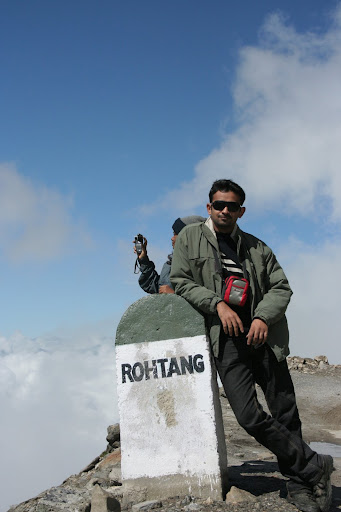Wake up to the sight of an extraordinarily beautiful scene - we're on a mountain road winding along the river
We aren't moving.
A leisurely morning walk to the end brings us to the culprit - a giant trailer, while negotiating turn, snagged the last set of it's wheels on the railing - and ripped the axle off. It's a monster that can't be budged without some serious heavy machinery.
We're walking back, figuring out how this will impact our itinerary, when A has a brainwave. Smaller vehicles can squeeze past; and there's a lot of empty Tata 207's parked, wondering whether to wait for clearance or just zip ahead. We grab one, load all the bags in and then ourselves on top of the bags, and hanging on for dear life, roar off.
After a journey through one looooong tunnel, a bus, another 207, and a cab, we finally reach the Glacier Resort, logo'ed by what looks like a drunk penguin.
An hour later, we're in a Qualis, headed for Rohtang.
Rohtang
It's a killer road, filled with slush and very disquieting signs reading 'Avalanche Point', a couple of glaciers carved with hearts, until we reach the pass.
Rohtang-la. It's a lovely place, with mist rolling through green mountains topped with black-white starkness.
But under the beauty, there's a faint taste of the true nature of the place - it's a cold, desperate spot, it's spirit etched with desperate hopes and prayers.
Roh-tang. Translation: 'The Pile of Dead Bodies'. When the silk caravans used to come through here, the journey would be so arduous in those days that travelers would die by the time they reached; the bodies would be piled up here before the caravans continued, the human detritus of the spice and silk trade.
The road to Rohtang is lined with hundreds of shops / stalls renting thick furs and snow jumpsuits in neon colors. First-timers are bullied into renting these with spine-chilling tales of the extreme cold; once you get there, you'll find droves of pink-cheeked tourists shuffling around in giant furs and boots and extremely embarassed expressions. You also find people who take it as a fashion statement; knowing this is the only place in
There's also the enfant terrible of Indian Tourism, the drunk dancer; it doesn't matter where he is, what the weather, and what the atmosphere; come sun, rain, wind, or snow, in waterfalls, deserts, ice fields or urban ghetto; he will put on his car stereo, open the beer, and dance the bhangra.
As we walk up, the mist rolls in, muting sound, hiding everything except the ground beneath our feet; each of us is a vague outline in the white, seemingly much more distant than before. Out of the grey fog, a huge tangle of prayer flags emerges gradually, taking shape, a bright, fluttering octopus in the white.
Stop on the way down at the Sagoo Valley Cafe at Marhi for hot aloo parathas, omelettes, and chai for lunch, watching fluorescent paragliders circle the valley around us.
Nothing beats that sensation of hot food when you're sitting in icy cold weather, toasty warm in a jacket while your fingertips, nose and ears go numb in cold and the skin of your face crinkles; and food tastes awesome. At high altitudes, the minimal calorie requirement is closer to 10,000 a day, compared to the regular 2,500 on the plains. You're burning that much extra just generating body heat; which also means you're always hungry, ferociously hungry.
A dramatic demonstration of the altitude happens from a pair of pants. We're close to Rohtang, nearly 13,000 feet up; the atmosphere is thinner here, so the UV radiation from the sun, stronger. Sunlight is harsh and hot; a pair of jeans that have been hung up to dry on the railing suddenly get washed in a patch of sunlight from a break in the clouds. Almost instantly, it's like they're being microwaved; steam starts visibly pouring off them in the light. You can almost hear them sizzle.

No comments:
Post a Comment